- ホーム
- Citrix
- 1Y0-401 - Designing Citrix XenDesktop 7.6 Solutions
- Citrix.1Y0-401.v2018-12-07.q250
- 質問140
有効的な1Y0-401問題集はJPNTest.com提供され、1Y0-401試験に合格することに役に立ちます!JPNTest.comは今最新1Y0-401試験問題集を提供します。JPNTest.com 1Y0-401試験問題集はもう更新されました。ここで1Y0-401問題集のテストエンジンを手に入れます。
1Y0-401問題集最新版のアクセス
「450問、30% ディスカウント、特別な割引コード:JPNshiken」
CGEには、クライアントのデフォルトプリンタのみをCitrixセッションで使用できるようにするベースラインポリシーがあります。
どのエンドユーザーグループがこれを上書きし、複数のプリンタをCitrixセッションで使用できるようにするには、例外ポリシーが必要ですか?
どのエンドユーザーグループがこれを上書きし、複数のプリンタをCitrixセッションで使用できるようにするには、例外ポリシーが必要ですか?
正解:C
説明/参照:
テストレット1
エグゼクティブサマリー
プロジェクトの概要
CGEは、北米に本拠を置く世界的に分散した上流(探鉱および生産)石油ガス会社です。 CGEの3つの主な事業分野は、北米、欧州、東南アジアです。 CGEには、国際的な探鉱機会のポートフォリオもあります。
CGEは、小規模の上流石油ガス会社として北米で始まりました。買収により、CGEは急速に成長し、世界中の企業を買収しました。これにより、システムと人的な視点から分権化されたITモデルが生まれました。
現在、CGEはいくつかのCitrixテクノロジを利用して、複数の大陸にまたがるグローバルエンドユーザベースにアプリケーション仮想化を提供しています。アプリケーション仮想化の現在のITモデルは、地域の場所に基づいています。各地域では独自のCitrix環境をホストし、ローカルエンドユーザーベースをサポートしています。 CGEは、アプリケーションおよびデスクトップ仮想化環境全体が、高可用性のNetScalerペアを備えた3つのデータセンターでホストされるグローバルなITモデルに移行しています。 CGEは、アプリケーションやパフォーマンスに関する過去の問題を軽減するために、エンドユーザグループに専用のデスクトップを提供したいと考えています。さらに、すべてのサイトで接続が遅くなるという問題を解決するためのインターネットアップグレードプロジェクトが進行中です。これにより、環境全体のレイテンシと帯域幅の問題が改善されます。
CGEは、既存のCitrix環境でベストプラクティスが実行されているかどうかを判断するためにCitrix Consultingに従事しました。統合された新しいCitrix環境用の設計ドキュメントを提供する。この新しい環境に移行する前に解決すべきリスクを指摘することです。この成果物は、要件収集フェーズの出力を表し、このエンゲージメントのアーキテクチャ設計段階で入力として使用されます。
インタラクティブな会合を通して、Citrix ConsultingはCGEの既存のCitrix XenApp環境と戦略的目標に関する情報を得ました。この情報を参照することにより、CGEは最も深刻なリスクを代表する領域を理解し、体系的に対応し、現在の環境のさまざまな面を改善し、将来の統合環境の設計段階に備えることができます。
プロジェクト目標
プロジェクトの過程で、CGEとCitrix Consultingはいくつかのプロジェクト目標を確認しました。以下に、これらの目標をまとめます。
* XenApp 6.x、XenServer、およびNetScaler Gatewayを含む既存のCitrix環境をサポートするCitrixコンポーネントの詳細な評価を実行します。
既存のCitrix環境(Active Directory、ストレージ、SQL、ネットワーキングなど)をサポートする関連する周辺コンポーネントを確認して、それぞれが現在のプロダクションワークロードと新しいCitrix環境をサポートできるかどうかを判断します。
*環境の成長をよりよく説明するために、運用上および環境上の改善を特定する。
概要
CGEは北米、ヨーロッパ、東南アジアの3つの主要地域にまたがっており、主な本部はヒューストンに位置しています。サブリージョンは各地域に存在し、それぞれに独自のCitrixインフラストラクチャがあります。電力と冷却のアップグレードが完了すると、ヒューストンは主要なデータセンターになり、ロンドンは第2のデータセンターになります。
次の図は、場所とネットワーク接続の種類を示しています。
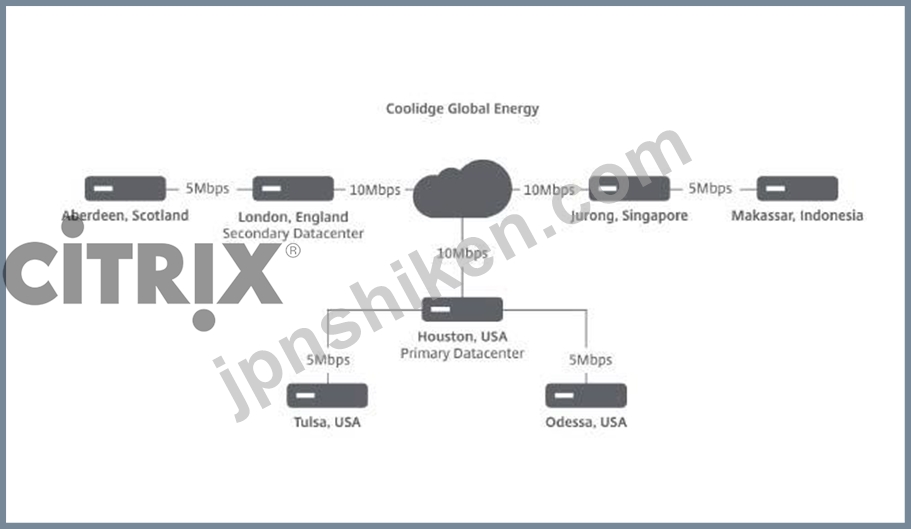
ビジネスレイヤの概要
買収によってCGEが急速に拡大したため、企業のIT部門は、買収した企業にインフラ管理を任せました。その結果、一部の地域ではCitrix環境が適切に機能していますが、他の地域では何百ものエンドユーザーに同時に影響を与える重大な停止が発生します。
CGEのCIO(CGEと1年弱の間にやっている)は、すべての地域でITの中心的な役割を果たすために雇われました。 CIOはさまざまなビジネスユニットと協力してプロセスを理解し、既存のCitrixインフラストラクチャの安定性に関するさまざまな苦情を受けました。
CIOは、Citrixのインフラストラクチャの問題の大部分は、集中管理と共通プラットフォームの不足が原因であると考えています。一部の地域にはXenAppの古いバージョンが含まれていますが、一部の地域には最新のバージョンがあります。 CGEが進むにつれて、CIOはソリューション全体に単一のベンダーを使用する予定であり、新しいインフラストラクチャが仮想化され、フォールトトレラントであることを保証したいと考えています。
エンドユーザ層の概要
CGEには10,350人の従業員がおり、そのうち約4,700人が毎日Citrix環境にアクセスします。ピークログオン時間は、地方の地域の時間帯に基づいて、月曜日から金曜日の午前8時から午前10時までです。
技術者とエンジニアは、24時間、週7日のスケジュールに対応するためにローテーションするシフト作業員です。
エンドユーザーの配布は次のとおりです。
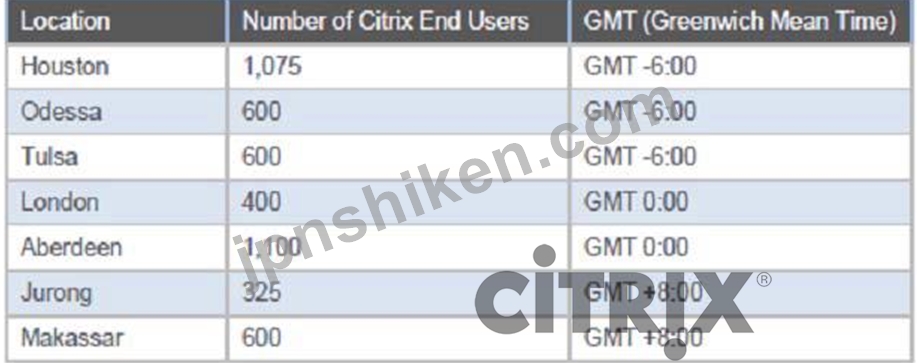
多くのエンドユーザは、CGE所有のHPノートブックおよびデスクトップデバイスを使用して接続します。これらのデバイスの90%以上は、CGEがWindows XPからWindows 7への移行を完了する過程にあるため、Windows 7ベースです。
CGEは、これらのデバイスをCitrix Online Plug-in for Windows12.1で標準化し、Receiver for Windows 4.2のテスト中です。過去には、タイピング時の遅さについてエンドユーザーの中には不満を持ちました。これは待ち時間の問題を示している可能性があります。
エンドユーザは、CGEを使用して、企業所有でないデバイスを使用して接続することもできます。多くのエンドユーザーは、パーソナルコンピュータやApple iPadsやiPhoneなどのモバイルデバイスから接続します。エンドユーザーは、Citrix WebサイトまたはAndroidまたはApple App StoreのいずれかからCitrix Receiverをダウンロードするように指示されます。
エンドユーザーは6つのカテゴリに分類できます。
*エグゼクティブ/マネジメント - 地域の上級管理職および中級管理職。
*バックオフィス - 会計、管理、人事、財務などの機能を提供するエンドユーザー。
*研究 - エンドユーザーは、主に新しいエネルギー分野や情報源の発見に焦点を当てています。
エンジニア - テクニシャンとテクニカルサポートを担当するエンドユーザ。 5人の技術者ごとに約1人のエンジニアがいます。
*技術者 - 石油ガス設備に従事する現場作業員。
*セールス - プライマリ顧客対応グループ。
エンドユーザーのグループと番号は次のとおりです。
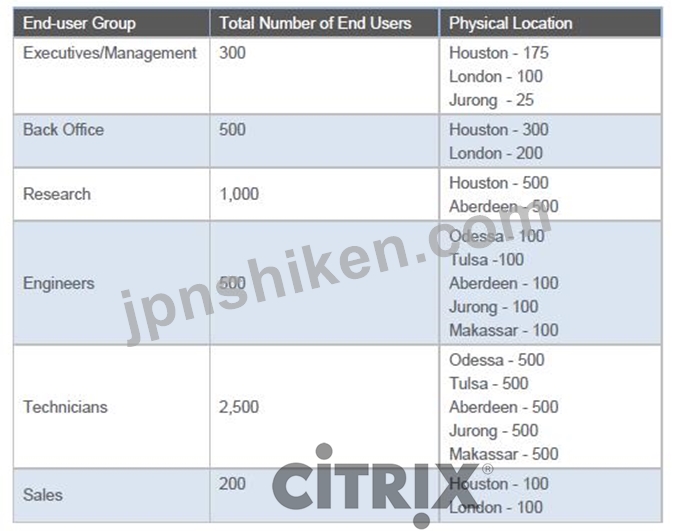
エンジニア、技術者、研究グループは主にオフィスタイプの環境でCitrixアプリケーションにアクセスしますが、ガスや油田の中でこれらのアプリケーションにアクセスする必要があります。これらのシナリオでは、エンドユーザーは、ワイヤレスアクセスポイントからテザリングされたモバイルデバイスに至るまで、ローカルインターネット接続を使用してCitrixに接続します。
プリンタドライバの問題やスプロールを防ぐため、CGEはCitrixにアクセスするときにエンドユーザーをデフォルトプリンタに制限しようとします。 CGEの本部のIT部門は、Citrixユニバーサルプリントドライバのみを利用することを義務づけています。各地域が独自のCitrixインフラストラクチャを管理しているため、これを実施することは困難でした。
各エンドユーザーのホームディレクトリは、Citrixセッションにアクセスするときにマップされます。ドライブマッピング文字は、エンドユーザーの地域によって異なります。エンドユーザーのデータは、Windows CIFS共有からNASアプライアンスまでのさまざまなネットワークデバイスタイプおよび共有に格納されます。エンドユーザーデータがすべての地域でバックアップされているかどうかは、企業のIT担当者には分かりません。 CGEは、新しいCitrix環境で正式な企業全体の標準を実装したいと考えています。
アクセスレイヤの概要
各地域には独自のCitrix環境があるため、エンドユーザーはそれぞれの地域でかなり隔離されています。
各地域では、NetScaler GatewayとWeb Interfaceを使用して、社内外のエンドユーザにアクセスできます。
一部の地域では、Citrix Secure Gatewayは引き続き外部アクセスに利用されています。これは主に過去の予算制約に起因するものですが、CGEは新しい環境のすべての地域で冗長でフォールトトレランスなCitrixアクセスソリューションを提供したいと考えています。適切なURLの使用と混同することは、地域間を移動するエンドユーザーにも発生します。エンドユーザーを最も近いデータセンターにルーティングする共通のアクセスポイントは、この混乱を最小限に抑える可能性があります。
CGEは新しいエネルギータイプと方法の開発に向けて行われている研究に敏感であるため、Citrix環境への外部アクセスは可能な限り安全でなければなりません。現在、社内外のエンドユーザはシングルファクタ認証を採用しています。しかしながら、2因子認証プロセスの開発が望まれている。
アクセスコントローラ
概要
次の表は、さまざまなCitrix環境でのWeb Interface、StoreFront、NetScaler Gateway、およびCitrix Secure Gatewayの使用状況を示しています。
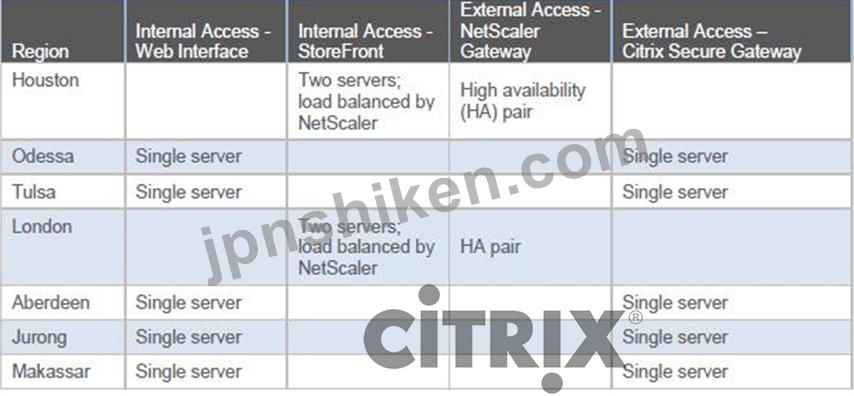
リソース層
パーソナライズの概要:

次の表に、現在の全体的なプロファイル戦略の概要を示します。
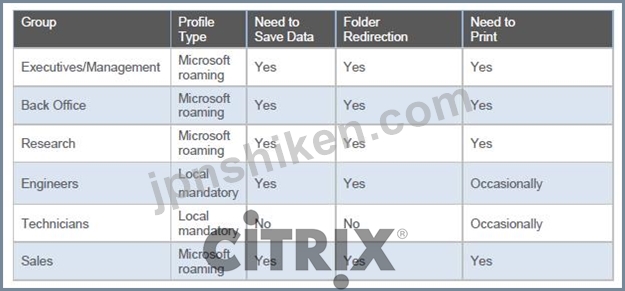
企業のIT部門は、プロファイル管理ソリューションを合理化したいと考えています。多くのエンドユーザーは、ログオン時間とログオフ時間が遅いことに不満を持ち、ルーチンのプロファイル破損も懸念しています。 IT部門では、日常的にエンドユーザーのプロファイルをリセットする必要があるのが一般的です。 CGEは、プロファイルをホストするための標準化されたハードウェアセットを実装し、Citrix Profile Managementを採用することにより、安定したエンドユーザープロファイルプラットフォームを提供したいと考えています。
Citrixのポリシーは地域によって異なりますが、企業のIT部門は以下のポリシー設定を実行しようとしています(最低限)。

技術者やエンジニアは、フローメータやソナー機器などのさまざまなフィールドデバイスにUSBマッピングを要求しています。残りのエンドユーザグループの大部分はおそらくUSBマッピングを必要としないため、新しい環境のグループではこれを無効にすることができます。
企業のIT部門は、ほとんどのエンドユーザーがCitrixセッション内でデフォルトプリンタのみを必要としていると感じています。ただし、他のエンドユーザーグループ(主にバックオフィス)は、ステープルなどの高度な印刷機能を備えた複数のプリンタにアクセスする必要があります。 In all cases, the need to limit native print drivers is critical.
Applications Overview:

The majority of end users utilize published applications delivered through one of the regional XenApp farms. Some end-user groups require a full desktop instead of published applications. CGE mandates that no new software (agents) may be deployed in the current desktop infrastructure.
The following table provides additional details about the applications and desktops used throughout the Citrix environments.
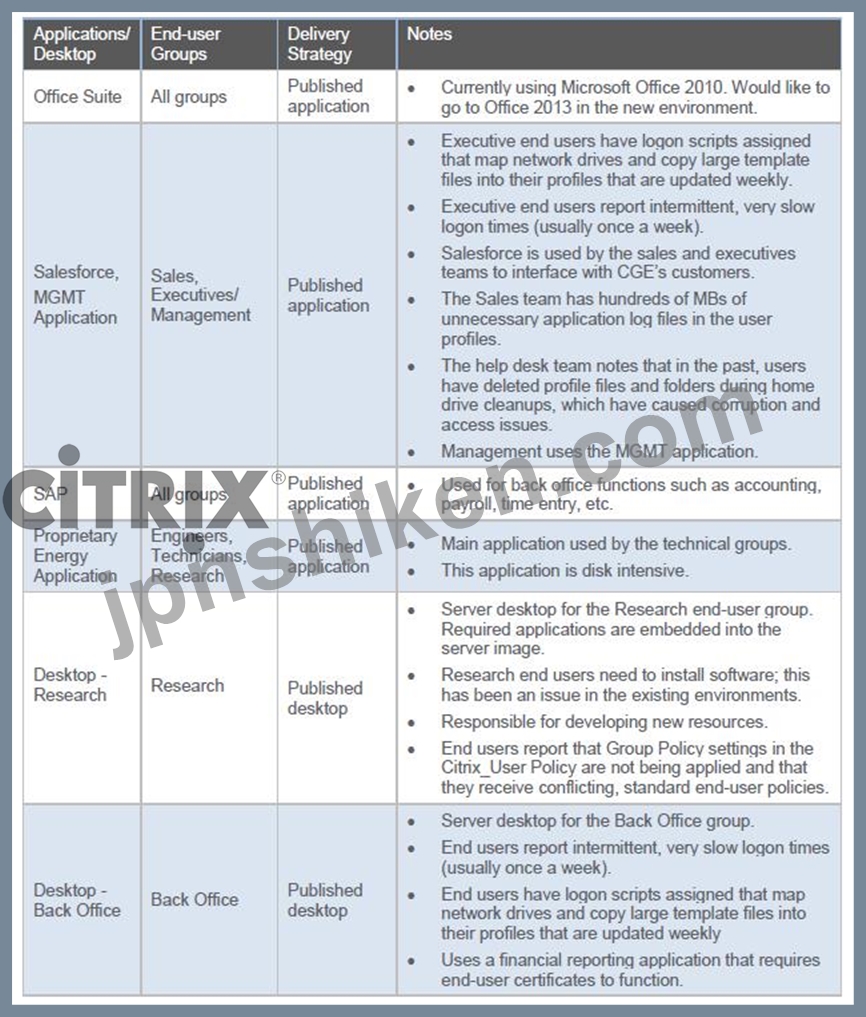

Image Design Overview:

The following table outlines current application specifics. All servers are Windows 2008 R2 running XenApp 6.5, and all are virtual machines. Applications are delivered based on grouping. For example, Office Suite is installed on a dedicated set of servers.

Control Layer
Infrastructure Services:

Active Directory
As the solution integrates with Active Directory, resources must be easy to manage and maintain within the directory structure. The following details CGE's typical organizational unit (OU) structure for the XenApp environments.
概要
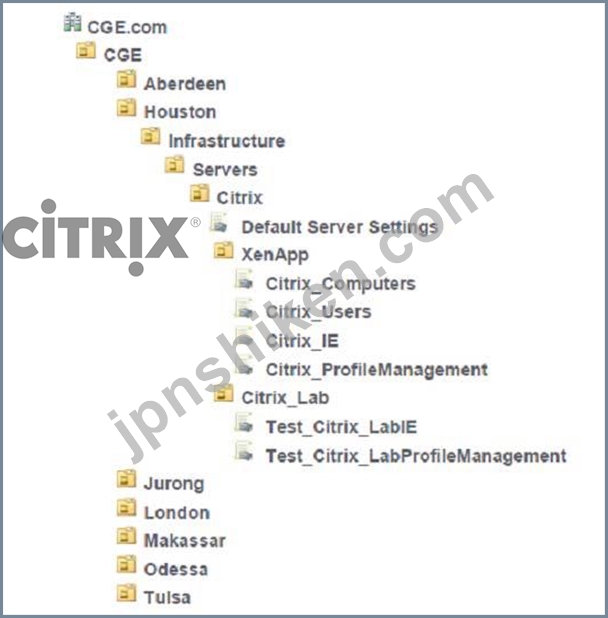
Databases Overview
CGE manages seven XenApp 6.5 farms-one for each region. A variety of SQL server versions host the farm databases. Some databases are located on a shared SQL cluster, while others are standalone.
The following table provides an overview of each environment, the database location, and the database configuration.
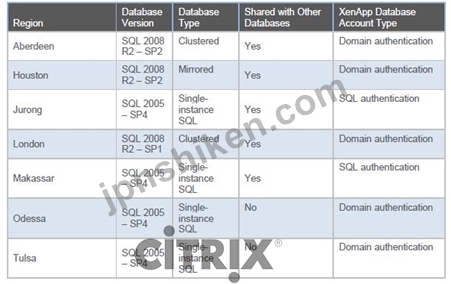
Licensing Overview
As each region currently manages its own Citrix infrastructure, licensing types vary from region to region.
Some regions have more licenses than end users, while others sometimes reach their limit. Each region has its own Citrix and Microsoft license servers.
Corporate IT will be consolidating the Citrix and Microsoft licenses under a common corporate agreement in the new Citrix environment. This will allow for better cost control and appropriate distribution of licenses.
If needed, additional licenses will be procured to support the new Citrix solution. This may involve purchasing additional Microsoft and Citrix licenses to support a disaster recovery model.
The following details the current Citrix and Microsoft license types.
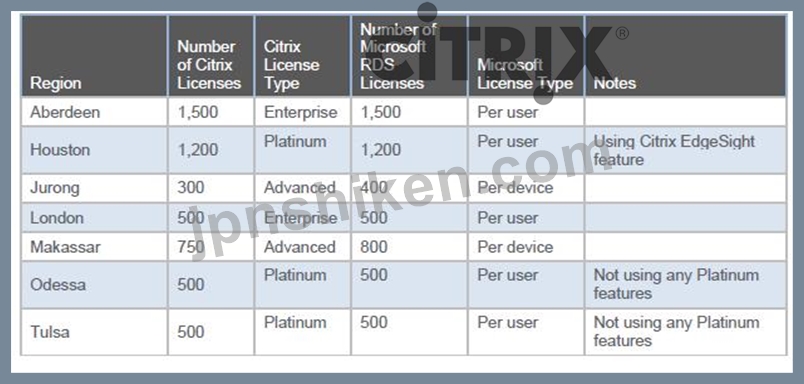
XenApp Controllers Overview:

All regions use virtualized XenApp 6.5 servers. Some regions currently use Provisioning Services 6.1, but CGE wants to simplify management processes by moving to Provisioning Services 7.6 in each region.
Although there are no test farms in the current Citrix environments, CGE would like to incorporate dedicated test environments in the new Citrix solution. These new test environments should utilize a minimum of storage. The following table details the XenApp environments for each region.

End users in some regions often complain about slow application enumeration and launch issues.
Corporate IT hopes that these issues will be resolved with the new Citrix solution.
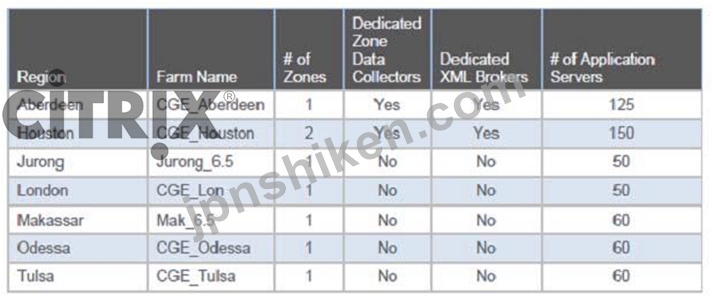
Hardware Layer
Storage Overview:

Depending on the region, the physical hosts that provide hardware virtualization use a variety of local and SAN-based storage. Using local storage has prevented virtual machines from moving to another host in the event of a host failure, creating some regional capacity issues. Corporate IT is unsure if end-user data is being backed up in all regions.
CGE hopes to implement global formal standards in the new Citrix environment. A fault-tolerant solution is required for hardware virtualization and end-user data storage.
The following table describes the different storage types based on region:
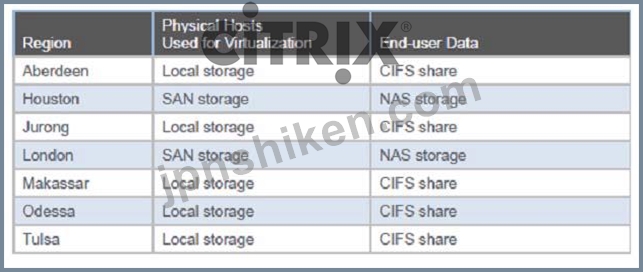
Networking Overview:

CGE utilizes regional private networks. Not all regions connect directly to each other. The network links range in size from 5 Mbps to 10 Mbps. The networks are congested at times among regions, causing large file copies to be scheduled during off hours to minimize disruption.
CGE currently has a project underway to increase the bandwidth among regions and reduce latency for the new Citrix environment. The following diagram details the links among the regions.
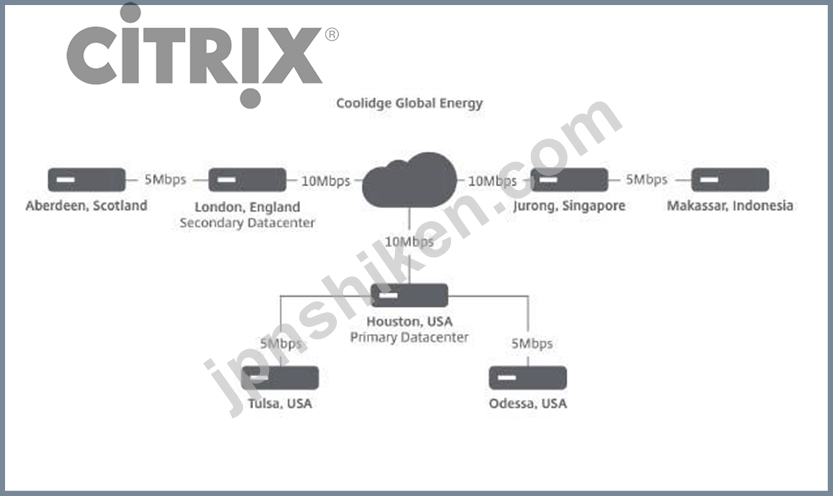
Each region has a separate Internet connection of varying capacity and utilizes its own local network connection for Internet traffic. Microsoft and routing policies are in place to direct Internet-bound traffic to use this local Internet connection. The goal was to reduce the amount traffic on the links among regions, saving bandwidth for interregional traffic.
For external Citrix access, each region uses its local Internet connection. The NetScaler Gateways and Citrix Secure Gateways are placed in a demilitarized zone (DMZ). Appropriate firewall ports are configured to allow the Citrix traffic to navigate to the internal resources.
Control Hosts Overview:

As CGE acquired several companies within a short period of time, it did not change any of the acquired companies' infrastructures. This has resulted in regional inconsistency in hypervisor platforms and versions and with hardware vendors.
Corporate IT hopes to streamline the infrastructure to ensure corporate standards are followed. At a minimum, a standard hypervisor platform must be used to allow IT resources to train on a common hypervisor platform and to quickly assist in other regions when needed.
For the new Citrix solution, CGE has budgeted for the replacement of aging infrastructure equipment, where needed, including the hypervisor platform. Procurement of the best infrastructure components within this planned budget must be ensured.
Operations Layer
Support Overview:

In the current configuration, each region is responsible for supporting its end users and infrastructure. This often leads to confusion for end users who travel, as well as the for the help desk members who work with these end users.
Corporate IT hopes to develop a centralized support structure from the end-user layer to the infrastructure layer. The CIO envisions a model that allows an end user to call one number for support. Regional staff will support the help desk 24 hours a day, seven days a week. If first-tier help desk support is unable to resolve the issue in a timely manner, a second-tier support team would be engaged.
In order to facilitate this troubleshooting model, the first-tier help desk and second-tier support teams would require access to the Citrix infrastructure. The CIO would prefer a centralized console for the help desk team, but it is not a requirement.
In the past, some regions had training budgets, while others did not. This has often resulted in lengthy resolution of issues due to improper training. To alleviate this, the CIO has mandated that the first-tier help desk and second-tier support teams be properly trained in the products being implemented in the new Citrix solution.
Testing and Change Control Overview:

An analysis revealed that none of the regions have a proper test environment. At best, some regions have a few test XenApp servers in their production farms that are used for testing. In addition, the procedures for implementing changes to the systems vary from region to region. Some regions have a documented change control process, while others install changes as application owners or end users request them.
This has resulted in overall poor performance of the Citrix environments and has caused outages in some regions.
The CIO has mandated that in the new Citrix solution, a change control board must approve changes, and a separate test environment must be deployed.
Operations Overview:

Citrix Rollups and hotfixes are applied sporadically throughout the Citrix farms. The following table details the implementation of Citrix Rollups.
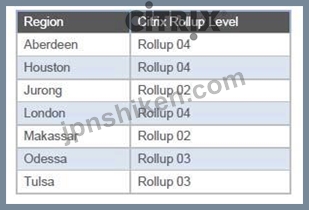
Backups of the Aberdeen, Houston, and London SQL databases are conducted daily via SQL. A nightly backup of the Windows server ensures that the local SQL backup is captured. However, the restoration process has not been tested. The remaining locations lack SQL administrators, so it is unclear if SQL backups are being performed.
The CIO recognizes this gap and is taking steps to ensure that all Citrix databases are routinely backed up. For the short term, the SQL administrators in the Houston location will assume responsibility for the SQL backups in the locations that lack SQL administrators.
Since each region has operated independently, no central disaster recovery plan exists. Corporate IT hopes to provide a seamless disaster recovery solution for all locations and believes that it may be possible to utilize regional resources with minimal overhead. Corporate IT feels that it is likely that, in the event of a disaster, only a subset of a region's end users would require a disaster recovery solution, and believes that approximately 50 percent of regional end users would be a good starting point.
Monitoring Overview:

The Houston location is the only location using EdgeSight. Corporate IT uses EdgeSight for license trending and occasional end-user troubleshooting. Interviews with the IT staff using EdgeSight revealed that EdgeSight could probably be better utilized. The help desk staff has tried using EdgeSight, but has felt overwhelmed and would prefer a much simpler interface to troubleshoot end-user issues.
CGE recently purchased Tivoli, an antivirus program, and is in the process of rolling it out to all locations.
Corporate IT has requested from Citrix Consulting any specific monitoring metrics and alerts related to the Citrix environment. CGE realizes that effective monitoring will allow them to be proactive in addressing issues before they cause critical outages.
The following is CGE's current antivirus policy:
* Periodic scanning of servers must be conducted at 1:00 a.m., local time, each morning.
* All workstations and servers must have antivirus software installed, and real-time scanning must be enabled.
* Periodic updating of antivirus software is required. Currently, antivirus updates are automatically delivered at 8:00 a.m., 1:00 p.m., 4:00 p.m., and 11:00 p.m., local time.
* Only vendor-required exclusions may be used, and all exclusions must be configured for both real-time and periodic scans.
* Real-time antivirus scanning must be configured to scan files when they are accessed and written.
* All servers must be configured to scan their local drives, and all remote network drive scanning must be disabled.
Corporate IT has shared several Citrix articles relating to Citrix product antivirus exclusions with the regions. It is unclear if the regions have implemented these exclusions.
テストレット1
エグゼクティブサマリー
プロジェクトの概要
CGEは、北米に本拠を置く世界的に分散した上流(探鉱および生産)石油ガス会社です。 CGEの3つの主な事業分野は、北米、欧州、東南アジアです。 CGEには、国際的な探鉱機会のポートフォリオもあります。
CGEは、小規模の上流石油ガス会社として北米で始まりました。買収により、CGEは急速に成長し、世界中の企業を買収しました。これにより、システムと人的な視点から分権化されたITモデルが生まれました。
現在、CGEはいくつかのCitrixテクノロジを利用して、複数の大陸にまたがるグローバルエンドユーザベースにアプリケーション仮想化を提供しています。アプリケーション仮想化の現在のITモデルは、地域の場所に基づいています。各地域では独自のCitrix環境をホストし、ローカルエンドユーザーベースをサポートしています。 CGEは、アプリケーションおよびデスクトップ仮想化環境全体が、高可用性のNetScalerペアを備えた3つのデータセンターでホストされるグローバルなITモデルに移行しています。 CGEは、アプリケーションやパフォーマンスに関する過去の問題を軽減するために、エンドユーザグループに専用のデスクトップを提供したいと考えています。さらに、すべてのサイトで接続が遅くなるという問題を解決するためのインターネットアップグレードプロジェクトが進行中です。これにより、環境全体のレイテンシと帯域幅の問題が改善されます。
CGEは、既存のCitrix環境でベストプラクティスが実行されているかどうかを判断するためにCitrix Consultingに従事しました。統合された新しいCitrix環境用の設計ドキュメントを提供する。この新しい環境に移行する前に解決すべきリスクを指摘することです。この成果物は、要件収集フェーズの出力を表し、このエンゲージメントのアーキテクチャ設計段階で入力として使用されます。
インタラクティブな会合を通して、Citrix ConsultingはCGEの既存のCitrix XenApp環境と戦略的目標に関する情報を得ました。この情報を参照することにより、CGEは最も深刻なリスクを代表する領域を理解し、体系的に対応し、現在の環境のさまざまな面を改善し、将来の統合環境の設計段階に備えることができます。
プロジェクト目標
プロジェクトの過程で、CGEとCitrix Consultingはいくつかのプロジェクト目標を確認しました。以下に、これらの目標をまとめます。
* XenApp 6.x、XenServer、およびNetScaler Gatewayを含む既存のCitrix環境をサポートするCitrixコンポーネントの詳細な評価を実行します。
既存のCitrix環境(Active Directory、ストレージ、SQL、ネットワーキングなど)をサポートする関連する周辺コンポーネントを確認して、それぞれが現在のプロダクションワークロードと新しいCitrix環境をサポートできるかどうかを判断します。
*環境の成長をよりよく説明するために、運用上および環境上の改善を特定する。
概要
CGEは北米、ヨーロッパ、東南アジアの3つの主要地域にまたがっており、主な本部はヒューストンに位置しています。サブリージョンは各地域に存在し、それぞれに独自のCitrixインフラストラクチャがあります。電力と冷却のアップグレードが完了すると、ヒューストンは主要なデータセンターになり、ロンドンは第2のデータセンターになります。
次の図は、場所とネットワーク接続の種類を示しています。

ビジネスレイヤの概要
買収によってCGEが急速に拡大したため、企業のIT部門は、買収した企業にインフラ管理を任せました。その結果、一部の地域ではCitrix環境が適切に機能していますが、他の地域では何百ものエンドユーザーに同時に影響を与える重大な停止が発生します。
CGEのCIO(CGEと1年弱の間にやっている)は、すべての地域でITの中心的な役割を果たすために雇われました。 CIOはさまざまなビジネスユニットと協力してプロセスを理解し、既存のCitrixインフラストラクチャの安定性に関するさまざまな苦情を受けました。
CIOは、Citrixのインフラストラクチャの問題の大部分は、集中管理と共通プラットフォームの不足が原因であると考えています。一部の地域にはXenAppの古いバージョンが含まれていますが、一部の地域には最新のバージョンがあります。 CGEが進むにつれて、CIOはソリューション全体に単一のベンダーを使用する予定であり、新しいインフラストラクチャが仮想化され、フォールトトレラントであることを保証したいと考えています。
エンドユーザ層の概要
CGEには10,350人の従業員がおり、そのうち約4,700人が毎日Citrix環境にアクセスします。ピークログオン時間は、地方の地域の時間帯に基づいて、月曜日から金曜日の午前8時から午前10時までです。
技術者とエンジニアは、24時間、週7日のスケジュールに対応するためにローテーションするシフト作業員です。
エンドユーザーの配布は次のとおりです。

多くのエンドユーザは、CGE所有のHPノートブックおよびデスクトップデバイスを使用して接続します。これらのデバイスの90%以上は、CGEがWindows XPからWindows 7への移行を完了する過程にあるため、Windows 7ベースです。
CGEは、これらのデバイスをCitrix Online Plug-in for Windows12.1で標準化し、Receiver for Windows 4.2のテスト中です。過去には、タイピング時の遅さについてエンドユーザーの中には不満を持ちました。これは待ち時間の問題を示している可能性があります。
エンドユーザは、CGEを使用して、企業所有でないデバイスを使用して接続することもできます。多くのエンドユーザーは、パーソナルコンピュータやApple iPadsやiPhoneなどのモバイルデバイスから接続します。エンドユーザーは、Citrix WebサイトまたはAndroidまたはApple App StoreのいずれかからCitrix Receiverをダウンロードするように指示されます。
エンドユーザーは6つのカテゴリに分類できます。
*エグゼクティブ/マネジメント - 地域の上級管理職および中級管理職。
*バックオフィス - 会計、管理、人事、財務などの機能を提供するエンドユーザー。
*研究 - エンドユーザーは、主に新しいエネルギー分野や情報源の発見に焦点を当てています。
エンジニア - テクニシャンとテクニカルサポートを担当するエンドユーザ。 5人の技術者ごとに約1人のエンジニアがいます。
*技術者 - 石油ガス設備に従事する現場作業員。
*セールス - プライマリ顧客対応グループ。
エンドユーザーのグループと番号は次のとおりです。

エンジニア、技術者、研究グループは主にオフィスタイプの環境でCitrixアプリケーションにアクセスしますが、ガスや油田の中でこれらのアプリケーションにアクセスする必要があります。これらのシナリオでは、エンドユーザーは、ワイヤレスアクセスポイントからテザリングされたモバイルデバイスに至るまで、ローカルインターネット接続を使用してCitrixに接続します。
プリンタドライバの問題やスプロールを防ぐため、CGEはCitrixにアクセスするときにエンドユーザーをデフォルトプリンタに制限しようとします。 CGEの本部のIT部門は、Citrixユニバーサルプリントドライバのみを利用することを義務づけています。各地域が独自のCitrixインフラストラクチャを管理しているため、これを実施することは困難でした。
各エンドユーザーのホームディレクトリは、Citrixセッションにアクセスするときにマップされます。ドライブマッピング文字は、エンドユーザーの地域によって異なります。エンドユーザーのデータは、Windows CIFS共有からNASアプライアンスまでのさまざまなネットワークデバイスタイプおよび共有に格納されます。エンドユーザーデータがすべての地域でバックアップされているかどうかは、企業のIT担当者には分かりません。 CGEは、新しいCitrix環境で正式な企業全体の標準を実装したいと考えています。
アクセスレイヤの概要
各地域には独自のCitrix環境があるため、エンドユーザーはそれぞれの地域でかなり隔離されています。
各地域では、NetScaler GatewayとWeb Interfaceを使用して、社内外のエンドユーザにアクセスできます。
一部の地域では、Citrix Secure Gatewayは引き続き外部アクセスに利用されています。これは主に過去の予算制約に起因するものですが、CGEは新しい環境のすべての地域で冗長でフォールトトレランスなCitrixアクセスソリューションを提供したいと考えています。適切なURLの使用と混同することは、地域間を移動するエンドユーザーにも発生します。エンドユーザーを最も近いデータセンターにルーティングする共通のアクセスポイントは、この混乱を最小限に抑える可能性があります。
CGEは新しいエネルギータイプと方法の開発に向けて行われている研究に敏感であるため、Citrix環境への外部アクセスは可能な限り安全でなければなりません。現在、社内外のエンドユーザはシングルファクタ認証を採用しています。しかしながら、2因子認証プロセスの開発が望まれている。
アクセスコントローラ
概要
次の表は、さまざまなCitrix環境でのWeb Interface、StoreFront、NetScaler Gateway、およびCitrix Secure Gatewayの使用状況を示しています。

リソース層
パーソナライズの概要:

次の表に、現在の全体的なプロファイル戦略の概要を示します。

企業のIT部門は、プロファイル管理ソリューションを合理化したいと考えています。多くのエンドユーザーは、ログオン時間とログオフ時間が遅いことに不満を持ち、ルーチンのプロファイル破損も懸念しています。 IT部門では、日常的にエンドユーザーのプロファイルをリセットする必要があるのが一般的です。 CGEは、プロファイルをホストするための標準化されたハードウェアセットを実装し、Citrix Profile Managementを採用することにより、安定したエンドユーザープロファイルプラットフォームを提供したいと考えています。
Citrixのポリシーは地域によって異なりますが、企業のIT部門は以下のポリシー設定を実行しようとしています(最低限)。

技術者やエンジニアは、フローメータやソナー機器などのさまざまなフィールドデバイスにUSBマッピングを要求しています。残りのエンドユーザグループの大部分はおそらくUSBマッピングを必要としないため、新しい環境のグループではこれを無効にすることができます。
企業のIT部門は、ほとんどのエンドユーザーがCitrixセッション内でデフォルトプリンタのみを必要としていると感じています。ただし、他のエンドユーザーグループ(主にバックオフィス)は、ステープルなどの高度な印刷機能を備えた複数のプリンタにアクセスする必要があります。 In all cases, the need to limit native print drivers is critical.
Applications Overview:

The majority of end users utilize published applications delivered through one of the regional XenApp farms. Some end-user groups require a full desktop instead of published applications. CGE mandates that no new software (agents) may be deployed in the current desktop infrastructure.
The following table provides additional details about the applications and desktops used throughout the Citrix environments.


Image Design Overview:

The following table outlines current application specifics. All servers are Windows 2008 R2 running XenApp 6.5, and all are virtual machines. Applications are delivered based on grouping. For example, Office Suite is installed on a dedicated set of servers.

Control Layer
Infrastructure Services:

Active Directory
As the solution integrates with Active Directory, resources must be easy to manage and maintain within the directory structure. The following details CGE's typical organizational unit (OU) structure for the XenApp environments.
概要

Databases Overview
CGE manages seven XenApp 6.5 farms-one for each region. A variety of SQL server versions host the farm databases. Some databases are located on a shared SQL cluster, while others are standalone.
The following table provides an overview of each environment, the database location, and the database configuration.

Licensing Overview
As each region currently manages its own Citrix infrastructure, licensing types vary from region to region.
Some regions have more licenses than end users, while others sometimes reach their limit. Each region has its own Citrix and Microsoft license servers.
Corporate IT will be consolidating the Citrix and Microsoft licenses under a common corporate agreement in the new Citrix environment. This will allow for better cost control and appropriate distribution of licenses.
If needed, additional licenses will be procured to support the new Citrix solution. This may involve purchasing additional Microsoft and Citrix licenses to support a disaster recovery model.
The following details the current Citrix and Microsoft license types.

XenApp Controllers Overview:

All regions use virtualized XenApp 6.5 servers. Some regions currently use Provisioning Services 6.1, but CGE wants to simplify management processes by moving to Provisioning Services 7.6 in each region.
Although there are no test farms in the current Citrix environments, CGE would like to incorporate dedicated test environments in the new Citrix solution. These new test environments should utilize a minimum of storage. The following table details the XenApp environments for each region.

End users in some regions often complain about slow application enumeration and launch issues.
Corporate IT hopes that these issues will be resolved with the new Citrix solution.

Hardware Layer
Storage Overview:

Depending on the region, the physical hosts that provide hardware virtualization use a variety of local and SAN-based storage. Using local storage has prevented virtual machines from moving to another host in the event of a host failure, creating some regional capacity issues. Corporate IT is unsure if end-user data is being backed up in all regions.
CGE hopes to implement global formal standards in the new Citrix environment. A fault-tolerant solution is required for hardware virtualization and end-user data storage.
The following table describes the different storage types based on region:

Networking Overview:

CGE utilizes regional private networks. Not all regions connect directly to each other. The network links range in size from 5 Mbps to 10 Mbps. The networks are congested at times among regions, causing large file copies to be scheduled during off hours to minimize disruption.
CGE currently has a project underway to increase the bandwidth among regions and reduce latency for the new Citrix environment. The following diagram details the links among the regions.

Each region has a separate Internet connection of varying capacity and utilizes its own local network connection for Internet traffic. Microsoft and routing policies are in place to direct Internet-bound traffic to use this local Internet connection. The goal was to reduce the amount traffic on the links among regions, saving bandwidth for interregional traffic.
For external Citrix access, each region uses its local Internet connection. The NetScaler Gateways and Citrix Secure Gateways are placed in a demilitarized zone (DMZ). Appropriate firewall ports are configured to allow the Citrix traffic to navigate to the internal resources.
Control Hosts Overview:

As CGE acquired several companies within a short period of time, it did not change any of the acquired companies' infrastructures. This has resulted in regional inconsistency in hypervisor platforms and versions and with hardware vendors.
Corporate IT hopes to streamline the infrastructure to ensure corporate standards are followed. At a minimum, a standard hypervisor platform must be used to allow IT resources to train on a common hypervisor platform and to quickly assist in other regions when needed.
For the new Citrix solution, CGE has budgeted for the replacement of aging infrastructure equipment, where needed, including the hypervisor platform. Procurement of the best infrastructure components within this planned budget must be ensured.
Operations Layer
Support Overview:

In the current configuration, each region is responsible for supporting its end users and infrastructure. This often leads to confusion for end users who travel, as well as the for the help desk members who work with these end users.
Corporate IT hopes to develop a centralized support structure from the end-user layer to the infrastructure layer. The CIO envisions a model that allows an end user to call one number for support. Regional staff will support the help desk 24 hours a day, seven days a week. If first-tier help desk support is unable to resolve the issue in a timely manner, a second-tier support team would be engaged.
In order to facilitate this troubleshooting model, the first-tier help desk and second-tier support teams would require access to the Citrix infrastructure. The CIO would prefer a centralized console for the help desk team, but it is not a requirement.
In the past, some regions had training budgets, while others did not. This has often resulted in lengthy resolution of issues due to improper training. To alleviate this, the CIO has mandated that the first-tier help desk and second-tier support teams be properly trained in the products being implemented in the new Citrix solution.
Testing and Change Control Overview:

An analysis revealed that none of the regions have a proper test environment. At best, some regions have a few test XenApp servers in their production farms that are used for testing. In addition, the procedures for implementing changes to the systems vary from region to region. Some regions have a documented change control process, while others install changes as application owners or end users request them.
This has resulted in overall poor performance of the Citrix environments and has caused outages in some regions.
The CIO has mandated that in the new Citrix solution, a change control board must approve changes, and a separate test environment must be deployed.
Operations Overview:

Citrix Rollups and hotfixes are applied sporadically throughout the Citrix farms. The following table details the implementation of Citrix Rollups.

Backups of the Aberdeen, Houston, and London SQL databases are conducted daily via SQL. A nightly backup of the Windows server ensures that the local SQL backup is captured. However, the restoration process has not been tested. The remaining locations lack SQL administrators, so it is unclear if SQL backups are being performed.
The CIO recognizes this gap and is taking steps to ensure that all Citrix databases are routinely backed up. For the short term, the SQL administrators in the Houston location will assume responsibility for the SQL backups in the locations that lack SQL administrators.
Since each region has operated independently, no central disaster recovery plan exists. Corporate IT hopes to provide a seamless disaster recovery solution for all locations and believes that it may be possible to utilize regional resources with minimal overhead. Corporate IT feels that it is likely that, in the event of a disaster, only a subset of a region's end users would require a disaster recovery solution, and believes that approximately 50 percent of regional end users would be a good starting point.
Monitoring Overview:

The Houston location is the only location using EdgeSight. Corporate IT uses EdgeSight for license trending and occasional end-user troubleshooting. Interviews with the IT staff using EdgeSight revealed that EdgeSight could probably be better utilized. The help desk staff has tried using EdgeSight, but has felt overwhelmed and would prefer a much simpler interface to troubleshoot end-user issues.
CGE recently purchased Tivoli, an antivirus program, and is in the process of rolling it out to all locations.
Corporate IT has requested from Citrix Consulting any specific monitoring metrics and alerts related to the Citrix environment. CGE realizes that effective monitoring will allow them to be proactive in addressing issues before they cause critical outages.
The following is CGE's current antivirus policy:
* Periodic scanning of servers must be conducted at 1:00 a.m., local time, each morning.
* All workstations and servers must have antivirus software installed, and real-time scanning must be enabled.
* Periodic updating of antivirus software is required. Currently, antivirus updates are automatically delivered at 8:00 a.m., 1:00 p.m., 4:00 p.m., and 11:00 p.m., local time.
* Only vendor-required exclusions may be used, and all exclusions must be configured for both real-time and periodic scans.
* Real-time antivirus scanning must be configured to scan files when they are accessed and written.
* All servers must be configured to scan their local drives, and all remote network drive scanning must be disabled.
Corporate IT has shared several Citrix articles relating to Citrix product antivirus exclusions with the regions. It is unclear if the regions have implemented these exclusions.
- 質問一覧「250問」
- 質問1 シナリオ: CGEはインフラストラクチャのワークロードを仮想化し...
- 質問2 シナリオ: CGEはサーバーのワークロードを仮想化し、すべてのエ...
- 質問3 シナリオ: Citrix Architectは、CGEの既存のXenApp環境のActive...
- 質問4 シナリオ: Citrix Architectは、CGE用のマルチサーバープロビジ...
- 質問5 シナリオ: CGEはインフラストラクチャのワークロードを仮想化し...
- 質問6 シナリオ: CGEのセキュリティ管理者は、ゲートウェイサービスの...
- 質問7 ゲストVMネットワーク用のボンディングされたネットワークインタ...
- 質問8 Citrix ArchitectがCGEのウイルス対策ポリシーを見直し、Citrix...
- 質問9 各データセンターに1つのProvisioning Servicesサーバーを持つ3...
- 質問10 シナリオ: Citrix Architectは、CGEの既存のXenApp環境のActive...
- 質問11 4つのNetScalerアプライアンスを導入するのはなぜですか?2つは...
- 質問12 各データセンターがHAペアで6つのNetScaler仮想サーバーを展開し...
- 質問13 シナリオ: CGEは、既存のプロファイル管理ソリューションで多数...
- 質問14 ストレージネットワーク用のネットワークインターフェイスを構成
- 質問15 シナリオ: Citrix Architectは、CGE用のマルチサーバープロビジ...
- 質問16 リサーチエンドユーザーグループにデスクトップを展開するために
- 質問17 どの2つのCGEエンドユーザグループが現在セッション間でプロファ...
- 質問18 各データセンターに2つのProvisioning Servicesサーバーがある3...
- 質問19 シナリオ: Citrix Architectは、CGE用のマルチサーバープロビジ...
- 質問20 シナリオ: CGEは、既存のプロファイル管理ソリューションで多数...
- 質問21 Citrix Architectが、ジュロンオフィスのエンドユーザーのセッシ...
- 質問22 Citrix Architectは、外部アクセスの現在の条項に基づいて、次の...
- 質問23 HAを使用するXenServerを使用してCIFSサーバ上の地域共有ストレ...
- 質問24 シナリオ: CGEはインフラストラクチャのワークロードを仮想化し...
- 質問25 各データセンターは、3つのサイトのサブネットで構成された3つの...
- 質問26 シナリオ: CGEは、既存のプロファイル管理ソリューションで多数...
- 質問27 シナリオ: Citrix Architectは、CGEの既存のXenApp環境のActive...
- 質問28 なぜ、2つのNetScalerアプライアンスを配備するのですか?1つは...
- 質問29 シナリオ: CGEはインフラストラクチャのワークロードを仮想化し...
- 質問30 シナリオ: Citrix Architectは、CGEの既存のXenApp環境のActive...
- 質問31 プライマリデータセンターに2つのProvisioning Servicesサーバー...
- 質問32 シナリオ: CGEは、既存のプロファイル管理ソリューションで多数...
- 質問33 シナリオ: CGEは、独自の16ビットアプリケーションであるMGMTを...
- 質問34 ストレージネットワークのネットワークインターフェイスを構成す
- 質問35 SQLデータストアが破損した場合、どのリスクが原因で長時間にわ...
- 質問36 シナリオ: CGEはインフラストラクチャのワークロードを仮想化し...
- 質問37 シナリオ: CGEはインフラストラクチャのワークロードを仮想化し...
- 質問38 NetScaler Gatewayへのログオンの失敗を一元的に監査するには、C...
- 質問39 シナリオ: CGEはインフラストラクチャのワークロードを仮想化し...
- 質問40 シナリオ: Citrix Architectは、CGEの既存のXenApp環境のActive...
- 質問41 シナリオ: CGEは、デスクトップイメージリリースの管理プロセス...
- 質問42 シナリオ: CGEはサーバーのワークロードを仮想化し、すべてのエ...
- 質問43 12のNetScalerアプライアンスを使用した設計はなぜですか?各デ...
- 質問44 シナリオ: CGEは、独自の16ビットアプリケーションであるMGMTを...
- 質問45 CGE環境のアクセス層にはどのような2つのリスクが存在しますか?...
- 質問46 シナリオ: CGEは、独自の16ビットアプリケーションであるMGMTを...
- 質問47 シナリオ: Citrix Architectは、CGEの既存のXenApp環境のActive...
- 質問48 Citrix Architectは、プールされたデスクトップがCGEのエンジニ...
- 質問49 シナリオ: 各XenServerホストには、4つの10GBネットワークカー...
- 質問50 シナリオ: CGEはサーバーのワークロードを仮想化し、すべてのエ...
- 質問51 シナリオ: CGEは、独自の16ビットアプリケーションであるMGMTを...
- 質問52 シナリオ: CGEは、既存のプロファイル管理ソリューションで多数...
- 質問53 シナリオ: CGEは、独自の16ビットアプリケーションであるMGMTを...
- 質問54 リサーチエンドユーザグループのために、どの2つのFlexCastモデ...
- 質問55 シナリオ: Citrix Architectは、CGEの既存のXenApp環境のActive...
- 質問56 シナリオ: Citrix Architectは、CGEの既存のXenApp環境のActive...
- 質問57 CGEのバックオフィスエンドユーザグループのプリンタドライバ管...
- 質問58 ストレージネットワークのネットワークインターフェイスを構成す
- 質問59 シナリオ: 各XenServerハイパーバイザホストは、ストレージ用に...
- 質問60 アーキテクトは、iSCSI SANをサポートするためにXenServerホスト...
- 質問61 各データセンターに3つのProvisioning Servicesサーバーを持つ3...
- 質問62 クラスタ化ファイルサービスを使用するCIFSサーバー上の地域共有...
- 質問63 アーキテクトが構成済みのサイトにインストールするProvisioning...
- 質問64 Citrix Architectは、SAPとOffice Suiteのイメージを1つのイメー...
- 質問65 技術者とエンジニアのエンドユーザーエクスペリエンスを向上させ
- 質問66 Citrix ArchitectがCGEのJurongおよびMakassarオフィスでHDX Mob...
- 質問67 シナリオ: CGEはサーバーのワークロードを仮想化し、すべてのエ...
- 質問68 シナリオ: Citrix Architectは、CGEの既存のXenApp環境のActive...
- 質問69 アーキテクトは、iSCSI NASをサポートするために、XenServer VM...
- 質問70 ゲストVMネットワーク用のボンディングされたネットワークインタ...
- 質問71 シナリオ: CGEは、独自の16ビットアプリケーションであるMGMTを...
- 質問72 シナリオ: Citrix Architectは、CGE用のマルチサーバープロビジ...
- 質問73 シナリオ: CGEはサーバーのワークロードを仮想化し、すべてのエ...
- 質問74 ゲストVMネットワーク用のボンディングされたネットワークインタ...
- 質問75 最適なエンドユーザーエクスペリエンスを確保するために、CGEが...
- 質問76 シナリオ: CGEはインフラストラクチャのワークロードを仮想化し...
- 質問77 なぜ、3つのサイトのサブネットで構成され、リダイレクションポ
- 質問78 シナリオ: CGEは、独自の16ビットアプリケーションであるMGMTを...
- 質問79 シナリオ: Citrix Architectは、CGEの新しい外部アクセスアーキ...
- 質問80 シナリオ: 各XenServerホストには、ストレージトラフィック用、...
- 質問81 CGEは、すべてのエンドユーザーが2要素認証を使用してCitrix環境...
- 質問82 シナリオ: Citrix Architectは、CGEの既存のXenApp環境のActive...
- 質問83 シナリオ: CGEはサーバーのワークロードを仮想化し、すべてのエ...
- 質問84 シナリオ: Citrix Architectは、CGEの既存のXenApp環境のActive...
- 質問85 シナリオ: コンプライアンス上の理由から、Delivery Controller...
- 質問86 シナリオ: エグゼクティブ/管理エンドユーザーグループは、タブ...
- 質問87 シナリオ: Citrix Architectは、CGE用のマルチサーバープロビジ...
- 質問88 シナリオ: Citrix Architectは、CGE用のマルチサーバープロビジ...
- 質問89 シナリオ: CGEは、独自の16ビットアプリケーションであるMGMTを...
- 質問90 シナリオ: CGEはインフラストラクチャのワークロードを仮想化し...
- 質問91 シナリオ: CGEはインフラストラクチャのワークロードを仮想化し...
- 質問92 シナリオ: Citrix Architectは、CGEの既存のXenApp環境のActive...
- 質問93 バックオフィスのエンドユーザグループには適していないプロファ
- 質問94 シナリオ: 次のCitrix環境をサポートするバックエンドSQLデータ...
- 質問95 なぜ、ゲストVMネットワークのネットワークインターフェイスを構...
- 質問96 シナリオ: Citrix Architectは、CGEの既存のXenApp環境のActive...
- 質問97 シナリオ: CGEには2つのStoreFrontサーバーグループがあります...
- 質問98 CGEのバックオフィスのエンドユーザーグループに関して、Citrix ...
- 質問99 シナリオ: CGEは、独自の16ビットアプリケーションであるMGMTを...
- 質問100 シナリオ: CGEはインフラストラクチャのワークロードを仮想化し...
- 質問101 シナリオ: CGEは、既存のプロファイル管理ソリューションで多数...
- 質問102 アーキテクトは、サイトの復元力を高めるためにNetScalerアプラ...
- 質問103 シナリオ: コンプライアンス上の理由から、Delivery Controller...
- 質問104 SAN上のiSCSI LUNをvDiskストレージの最適な設計方法として選択...
- 質問105 シナリオ: コンプライアンス上の理由から、Delivery Controller...
- 質問106 シナリオ: CGEは、既存のプロファイル管理ソリューションで多数...
- 質問107 シナリオ: CGEは、既存のプロファイル管理ソリューションで多数...
- 質問108 シナリオ: コンプライアンス上の理由から、Delivery Controller...
- 質問109 シナリオ: CGEは、デスクトップイメージリリースの管理プロセス...
- 質問110 現在の外部アクセスの規定に基づいて、CGE環境の可用性にリスク...
- 質問111 シナリオ: CGEはインフラストラクチャのワークロードを仮想化し...
- 質問112 Citrix ArchitectがCGEのリモートアクセスソリューションを設計...
- 質問113 シナリオ: CGEは、デスクトップイメージリリースの管理プロセス...
- 質問114 なぜDNS Round Robinを使用してCIFSサーバー上の地域の共有スト...
- 質問115 Provisioning Servicesが常にProvisioning Servicesイメージにア...
- 質問116 シナリオ: CGEは、デスクトップイメージリリースの管理プロセス...
- 質問117 3つのファームのそれぞれに、アーキテクトがインストールするPro...
- 質問118 シナリオ: Citrix Architectは、CGEの新しい外部アクセスアーキ...
- 質問119 CGEの新しい仮想化設計でCitrix Architectが解決すべき現在のラ...
- 質問120 NAS上のiSCSI LUNをvDiskストレージの最適な設計に選択する理由...
- 質問121 シナリオ: CGEは、独自の16ビットアプリケーションであるMGMTを...
- 質問122 分散ファイルサービスを使用するCIFSサーバー上の地域共有ストレ...
- 質問123 シナリオ: Citrix Architectは、CGEの新しい外部アクセスアーキ...
- 質問124 シナリオ: CGEはインフラストラクチャのワークロードを仮想化し...
- 質問125 シナリオ: CGEは、既存のプロファイル管理ソリューションで多数...
- 質問126 シナリオ: CGEは、デスクトップイメージリリースの管理プロセス...
- 質問127 シナリオ: Citrix Architectは、CGEの新しい外部アクセスアーキ...
- 質問128 Citrix Architectは、地域単位の単一イメージ管理戦略の実装が必...
- 質問129 シナリオ: CGEはインフラストラクチャのワークロードを仮想化し...
- 質問130 シナリオ: CGEはインフラストラクチャのワークロードを仮想化し...
- 質問131 シナリオ: CGEはインフラストラクチャのワークロードを仮想化し...
- 質問132 シナリオ: CGEは、独自の16ビットアプリケーションであるMGMTを...
- 質問133 NetScalerアプライアンスを4台(プライマリに2台、セカンダリデ...
- 質問134 シナリオ: CGEはインフラストラクチャのワークロードを仮想化し...
- 質問135 シナリオ: Citrix Architectは、CGE用のマルチサーバープロビジ...
- 質問136 シナリオ: CGEは、デスクトップイメージリリースの管理プロセス...
- 質問137 シナリオ: CGEは、独自の16ビットアプリケーションであるMGMTを...
- 質問138 シナリオ: Citrix Architectは、CGEの既存のXenApp環境のActive...
- 質問139 シナリオ: CGEはインフラストラクチャのワークロードを仮想化し...
- 質問140 CGEには、クライアントのデフォルトプリンタのみをCitrixセッシ...
- 質問141 各サイトに1つの構成済みサイトを持つ3つのファームと、各ファー...
- 質問142 シナリオ: Citrix Architectは、CGEの既存のXenApp環境のActive...
- 質問143 シナリオ: CGEは、デスクトップイメージリリースの管理プロセス...
- 質問144 シナリオ: CGEはインフラストラクチャのワークロードを仮想化し...
- 質問145 シナリオ: CGEはインフラストラクチャのワークロードを仮想化し...
- 質問146 シナリオ: CGEはインフラストラクチャのワークロードを仮想化し...
- 質問147 シナリオ: CGEは、デスクトップイメージリリースの管理プロセス...
- 質問148 CGEの現在の展開における潜在的な問題の原因としてCitrix Archit...
- 質問149 シナリオ: Citrix Architectは、CGE用のマルチサーバープロビジ...
- 質問150 シナリオ: CGEは、既存のプロファイル管理ソリューションで多数...
- 質問151 ゲストVMネットワーク用のボンディングされたネットワークインタ...
- 質問152 シナリオ: CGEはインフラストラクチャのワークロードを仮想化し...
- 質問153 なぜなら、12台のNetScalerアプライアンスを使用した設計では、...
- 質問154 Citrix Architectは、CGEのJurongデータセンターで仮想環境を更...
- 質問155 Provisioning ServicesがProvisioning Servicesのイメージに常に...
- 質問156 シナリオ: CGEは、独自の16ビットアプリケーションであるMGMTを...
- 質問157 シナリオ: CGEはインフラストラクチャのワークロードを仮想化し...
- 質問158 シナリオ: 新しいソリューションのセキュリティを確保するため
- 質問159 シナリオ: CGEのJurongオフィスのCitrixアーキテクトは、東南ア...
- 質問160 CGEの現在のホームディレクトリのストレージ戦略がもたらす2つの...
- 質問161 シナリオ: CGEは、デスクトップイメージリリースの管理プロセス...
- 質問162 シナリオ: CGEはインフラストラクチャのワークロードを仮想化し...
- 質問163 シナリオ: Citrix Architectは、CGEの既存のXenApp環境のActive...
- 質問164 シナリオ: CGEは、デスクトップイメージリリースの管理プロセス...
- 質問165 なぜNAS上のCIFSをvDiskストレージの最適な設計ソリューションに...
- 質問166 シナリオ: CGEは、既存のプロファイル管理ソリューションで多数...
- 質問167 企業のWindows 7クライアントを変更すると、エンドユーザーのAct...
- 質問168 なぜ3つのサイトのサブネットで3つのNetScaler仮想サーバーを構...
- 質問169 シナリオ: Citrix Architectは、CGE用のマルチサーバープロビジ...
- 質問170 シナリオ: Citrix Architectは、CGEの既存のXenApp環境のActive...
- 質問171 シナリオ: CGEはインフラストラクチャのワークロードを仮想化し...
- 質問172 NetScaler仮想アプライアンスをリダイレクションポリシーにバイ...
- 質問173 プライマリおよびセカンダリのデータセンターに2つのNetScalerア...
- 質問174 シナリオ: コンプライアンス上の理由から、Delivery Controller...
- 質問175 シナリオ: Citrix Architectは、CGEの既存のXenApp環境のActive...
- 質問176 プライマリとセカンダリのデータセンターに2つのNetScalerアプラ...
- 質問177 シナリオ: CGEは、独自の16ビットアプリケーションであるMGMTを...
- 質問178 Citrix Architectは、CGEの環境でエンドユーザーとアプリケーシ...
- 質問179 シナリオ: CGEのCIOは、Citrix Architectに新しいProvisioning ...
- 質問180 シナリオ: Citrix Architectは、CGE用のマルチサーバープロビジ...
- 質問181 シナリオ: CGEは、既存のプロファイル管理ソリューションで多数...
- 質問182 シナリオ: CGEは、デスクトップイメージリリースの管理プロセス...
- 質問183 シナリオ: CGEは、デスクトップイメージリリースの管理プロセス...
- 質問184 シナリオ: CGEは、デスクトップイメージリリースの管理プロセス...
- 質問185 シナリオ: CGEはインフラストラクチャのワークロードを仮想化し...
- 質問186 ゲストVMネットワーク用のボンディングされたネットワークインタ...
- 質問187 シナリオ: CGEは、独自の16ビットアプリケーションであるMGMTを...
- 質問188 シナリオ: CGEは、デスクトップイメージリリースの管理プロセス...
- 質問189 ヒューストンのオフィスのエグゼクティブ/管理およびバックオフ
- 質問190 どのオプションで、各データセンターでのエンドユーザーアクセス
- 質問191 シナリオ:Citrix Architectは、CGEのAberdeenエンジニアのエン...
- 質問192 シナリオ:CGEのアプリケーションの分析によれば、98%はWindows...
- 質問193 シナリオ: CGEはサーバーのワークロードを仮想化し、すべてのエ...
- 質問194 シナリオ: CGEはインフラストラクチャのワークロードを仮想化し...
- 質問195 シナリオ: コンプライアンス上の理由から、Delivery Controller...
- 質問196 シナリオ: CGEは、NetScaler Insightを使用して、Citrix環境へ...
- 質問197 シナリオ: CGEは、Citrixポリシーを使用して新しい環境のすべて...
- 質問198 シナリオ: CGEは、デスクトップイメージリリースの管理プロセス...
- 質問199 アーキテクトは、12のNetScalerアプライアンスで高可用性(HA)...
- 質問200 シナリオ: CGEはサーバーのワークロードを仮想化し、すべてのエ...
- 質問201 シナリオ: Citrix Architectは、CGEの既存のXenApp環境のActive...
- 質問202 シナリオ: コンプライアンス上の理由から、Delivery Controller...
- 質問203 シナリオ: CGEはインフラストラクチャのワークロードを仮想化し...
- 質問204 シナリオ: CGEは、独自の16ビットアプリケーションであるMGMTを...
- 質問205 ストレージネットワークのネットワークインターフェイスを構成す
- 質問206 シナリオ: CGEはインフラストラクチャのワークロードを仮想化し...
- 質問207 シナリオ: CGEのCIOは、Citrix ArchitectにHypervisorネットワ...
- 質問208 なぜ各地域のデータセンターに2つのNetScalerアプライアンスを配...
- 質問209 アーキテクトは4つのアプライアンスでNetScaler仮想サーバーをど...
- 質問210 プライマリデータセンターに2つ、プライマリデータセンターに2つ...
- 質問211 Citrix Architectがエンドユーザーに対処すべき2つの問題は何で...
- 質問212 シナリオ: CGEは、独自の16ビットアプリケーションであるMGMTを...
- 質問213 シナリオ: Citrix Architectは、CGE用のマルチサーバープロビジ...
- 質問214 シナリオ: CGEは、デスクトップイメージリリースの管理プロセス...
- 質問215 ヒューストンのデータセンターにXenDesktop仮想デスクトップソリ...
- 質問216 シナリオ: CGEは、既存のプロファイル管理ソリューションで多数...
- 質問217 シナリオ: CGEはインフラストラクチャのワークロードを仮想化し...
- 質問218 シナリオ: CGEは、既存のプロファイル管理ソリューションで多数...
- 質問219 シナリオ: Citrix Architectは、CGE用のマルチサーバープロビジ...
- 質問220 シナリオ: CGEは、独自の16ビットアプリケーションであるMGMTを...
- 質問221 シナリオ: 各XenServerホストには、ストレージ、管理、およびゲ...
- 質問222 シナリオ: CGEは新しいStoreFront 2.6インフラを導入したいと考...
- 質問223 シナリオ: CGEは、既存のプロファイル管理ソリューションで多数...
- 質問224 シナリオ: CGEはインフラストラクチャのワークロードを仮想化し...
- 質問225 各地域のデータセンターに2台のNetScalerアプライアンスを配備す...
- 質問226 シナリオ: CGEは、デスクトップイメージリリースの管理プロセス...
- 質問227 シナリオ: Citrix Architectは、CGEの新しい外部アクセスアーキ...
- 質問228 シナリオ: Citrix Architectは、CGEの既存のXenApp環境のActive...
- 質問229 シナリオ: CGEはインフラストラクチャのワークロードを仮想化し...
- 質問230 シナリオ: 次のCitrix環境をサポートするバックエンドSQLデータ...
- 質問231 シナリオ: CGEのセキュリティ管理者は、ゲートウェイサービスの...
- 質問232 プライマリとセカンダリのデータセンターに2つのNetScalerアプラ...
- 質問233 シナリオ:エンジニアのエンドユーザーグループは、インターネッ
- 質問234 どの2要素認証ソリューションが現在のCGE環境のギャップを解決し...
- 質問235 シナリオ: CGEは、デスクトップイメージリリースの管理プロセス...
- 質問236 シナリオ: CGEはサーバーのワークロードを仮想化し、すべてのエ...
- 質問237 構成済みの3つのサイトのそれぞれに、アーキテクトがインストー
- 質問238 シナリオ: CGEはインフラストラクチャのワークロードを仮想化し...
- 質問239 プライマリに2つ、セカンダリデータセンターに2つのNetScalerア...
- 質問240 シナリオ: コンプライアンス上の理由から、Delivery Controller...
- 質問241 アーキテクトが3つの構成済みサイトにインストールするProvision...
- 質問242 シナリオ:StoreFrontは専用サーバーにインストールされています...
- 質問243 シナリオ: コンプライアンス上の理由から、Delivery Controller...
- 質問244 シナリオ: CGEは、独自の16ビットアプリケーションであるMGMTを...
- 質問245 シナリオ: CGEは、既存のプロファイル管理ソリューションで多数...
- 質問246 シナリオ: CGEにはオフィスアプリケーションをホスティングする...
- 質問247 シナリオ: Citrix Architectは、CGEの既存のXenApp環境のActive...
- 質問248 Citrix ArchitectがCGEの既存のプリンタモデルを文書化するため...
- 質問249 シナリオ:Citrix Architectは、CGEのProvisioning Services 6.1...
- 質問250 シナリオ: CGEは、既存のプロファイル管理ソリューションで多数...

